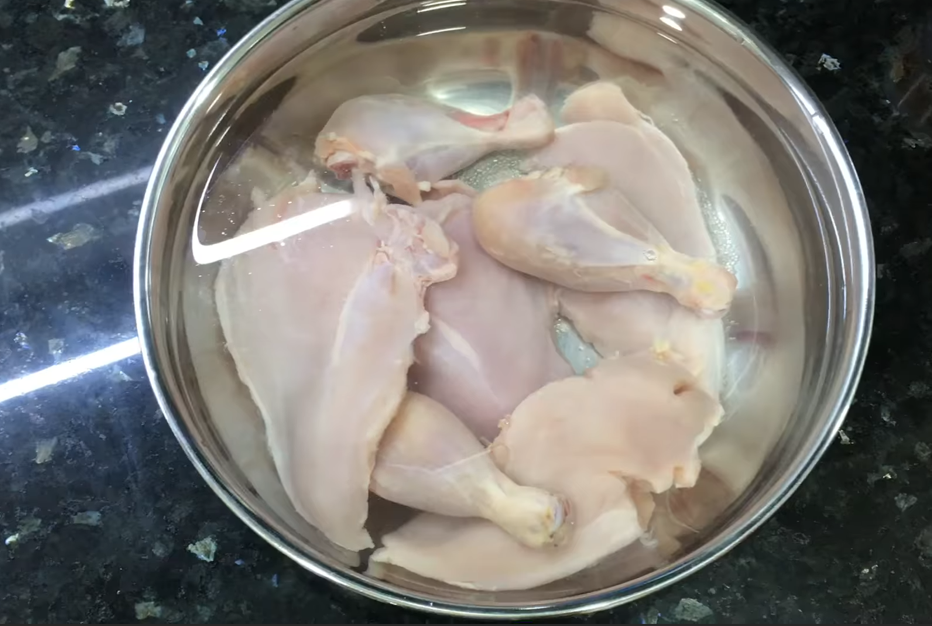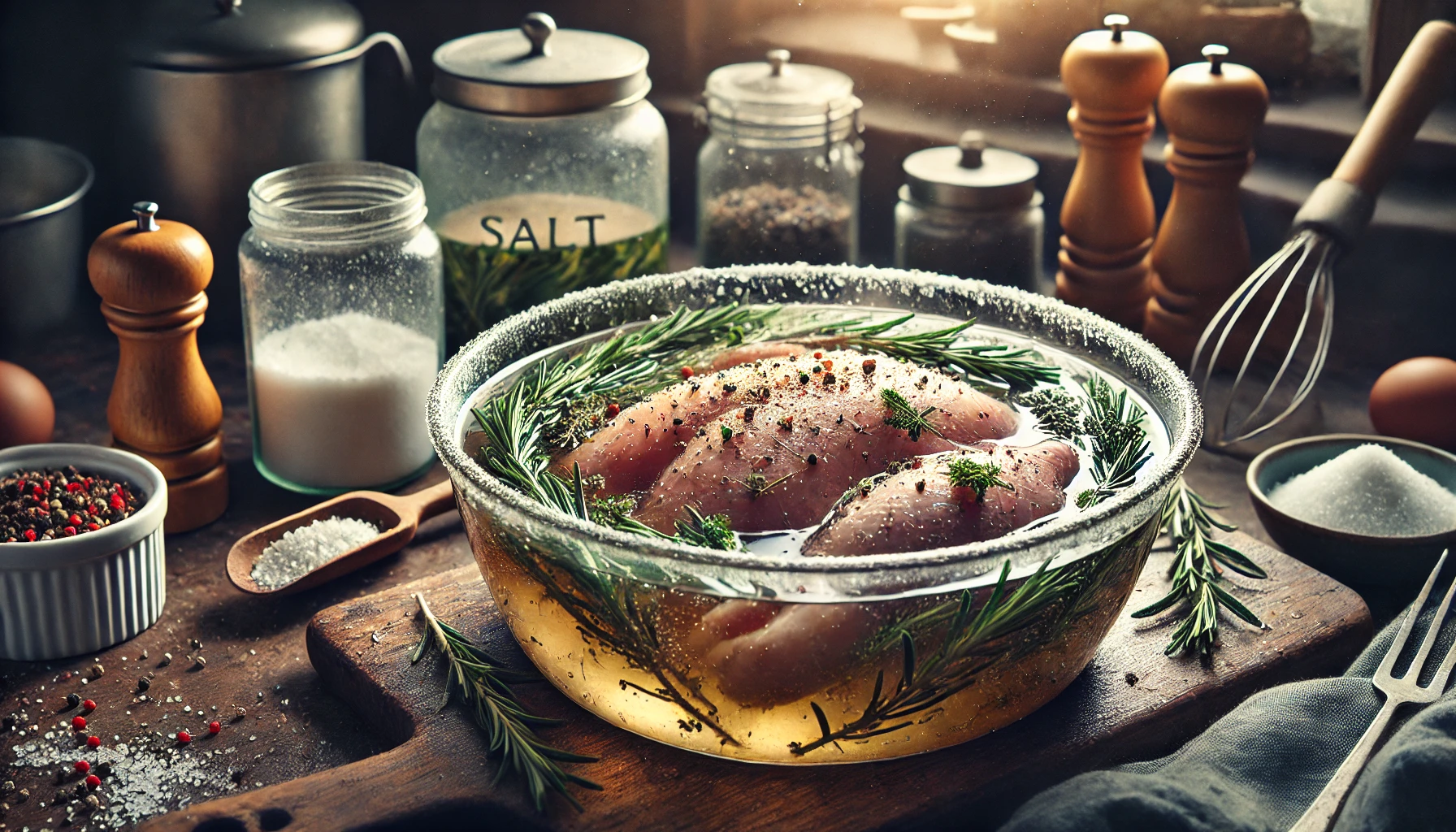Introduction to the rule for brine
What is Brining?
Brining is a cooking technique that revolves around a simple yet powerful concept: using a saltwater solution to enhance the flavor and texture of meat. Understanding the rule for brine is key to mastering this technique. At its core, the rule for brine involves soaking meat in a mixture of water, salt, and sometimes sugar and spices. This solution helps the meat retain moisture during cooking, making it juicier and more flavorful. Knowing the rule for brine can transform your cooking, whether you’re preparing poultry, pork, or even certain cuts of beef.
The Rule for brine has been a part of culinary traditions for centuries. Originally, people used brining primarily for preserving meat. Over time, however, cooks discovered that the rule for brine not only preserved meat but also improved its taste and texture. Today, the rule for brine is a standard practice in kitchens worldwide, especially when preparing dishes that might otherwise turn out dry.
Why Brining is Essential for Meat Preparation

Why is the rule for brine so important? Simply put, following the rule for brine makes your meat taste better. When you brine, you’re not just soaking the meat in saltwater. The salt penetrates the meat, breaking down some of the proteins. This process, dictated by the rule for brine, helps the meat retain more moisture during cooking. The result? A juicier, more flavorful dish that’s less likely to dry out.
But it’s not just about moisture. The rule for brine also allows you to infuse the meat with additional flavors. By adding herbs, spices, and even sweeteners like sugar or honey to your brine, you can create a complex flavor profile that elevates your dish. This is particularly useful for meats like chicken , which can sometimes be bland on their own.
The Basic Rule for Brining
Understanding the Salt-to-Water Ratio
When it comes to brining, one of the most important things to get right is the salt-to-water ratio. This ratio is the foundation of any good brine. The standard rule for a basic brine is to use 1 cup of kosher salt per gallon of water. This ratio ensures that your brine has enough salt to do its job without overpowering the natural flavor of the meat.
But not all salts are created equal. For instance, kosher salt, which is less dense, is typically preferred for brining. If you’re using table salt, which is denser, you’ll need to reduce the amount slightly—about ¾ cup per gallon of water. Sea salt can also be used, but it tends to be more expensive and might add a slightly different flavor to the brine.
Adjusting the salt-to-water ratio is crucial when dealing with different types of meat or when you’re brining for extended periods. Too much salt can make the meat too salty, while too little won’t give you the full benefits of brining. The key is to find the balance that works for your specific recipe and taste preferences.
Brining Time: The Rule of Thumb
Just as important as the salt-to-water ratio is the brining time. The general rule of thumb is to brine meat for one hour per pound. This rule works well for most cuts of meat, ensuring they absorb enough of the brine to stay juicy without becoming overly salty.
However, brining time can vary depending on the thickness and type of meat. Thicker cuts, like a whole turkey, might need more time—up to 12 hours or even overnight. On the other hand, thinner cuts, like chicken breasts, might only need 30 minutes to an hour. It’s all about striking the right balance. You want enough time for the salt to penetrate the meat without causing it to become overly salty or mushy.
Adjusting the brining time is also essential if you’re using a more concentrated brine. A stronger brine solution might require a shorter brining time to prevent over-salting. So, whether you’re brining a holiday turkey or a weeknight chicken dinner, keep the one-hour-per-pound rule in mind, but be ready to adjust based on the specific circumstances.
Additional Ingredients and Their Role
While salt and water are the primary components of any brine, additional ingredients can take your brine to the next level. Adding sugar, for instance, not only balances the saltiness but also helps with browning the meat during cooking. Herbs like rosemary, thyme, and bay leaves can infuse the meat with earthy flavors, while spices like peppercorns and garlic add a bit of heat and depth.
When adding these ingredients, it’s essential to maintain balance. You want to enhance the meat’s natural flavor without overpowering it. For most brines, a simple combination of salt, sugar, and a few herbs is enough to create a flavorful result. However, you can experiment with different combinations to find what works best for your taste.
Remember, the key to a successful brine isn’t just the salt-to-water ratio—it’s also about the flavors you add to the mix. These additional ingredients can transform a simple brine into something truly special, making your meat not just juicy, but bursting with flavor.
Different Types of Brining According to the Rule for Brine
Wet Brining
Wet brining is the most traditional form of brining. It involves fully submerging the meat in a mixture of water, salt, and other flavor-enhancing ingredients. This method is particularly effective for larger cuts of meat, like whole chickens or turkeys, where you want to ensure that the brine penetrates deeply into the meat.
To start, prepare your brine using the standard salt-to-water ratio—1 cup of kosher salt per gallon of water. Dissolve the salt completely, and then add any additional ingredients, such as sugar, herbs, and spices. Once the brine is ready, submerge the meat entirely, making sure it’s fully covered by the liquid. Then, refrigerate the meat for the recommended time based on its weight.
Wet brining is especially beneficial for meats that tend to dry out during cooking. The moisture from the brine helps to keep the meat juicy, even if it’s cooked a bit longer than intended. This method is ideal for holiday roasts or any dish where you want to ensure the meat stays tender and flavorful.
Dry Brining
Dry brining is a less messy alternative to wet brining and is becoming increasingly popular among home cooks and professional chefs alike. Instead of soaking the meat in a liquid solution, you rub it with a mixture of salt and other seasonings. The salt draws out the meat’s natural juices, which then mix with the salt and are reabsorbed, seasoning the meat from the inside out.
The process for dry brining is simple. Start by rubbing the meat with a mixture of kosher salt (usually 1 tablespoon per 5 pounds of meat) and any other desired seasonings. Once the meat is thoroughly coated, place it on a rack over a baking sheet and refrigerate it, uncovered, for the recommended time.
One of the key benefits of dry brining is that it helps to achieve a crispier skin, especially on poultry. Since there’s no liquid involved, the skin dries out during the brining process, which leads to better browning and crispiness during cooking. Dry brining is perfect for smaller cuts of meat or when you want to enhance the natural flavors without adding extra moisture.
Quick Brining
Sometimes, you don’t have the luxury of time for a traditional brine. That’s where quick brining comes in. Quick brining is a faster process that still delivers flavorful, juicy results. It’s particularly useful when you’re short on time but still want the benefits of brining.
To quick brine, use the same salt-to-water ratio but reduce the brining time significantly—typically to 15 to 30 minutes. This method is best for smaller cuts of meat, like chicken breasts or pork chops, which can absorb the brine quickly.
Quick brining doesn’t offer the same deep flavor penetration as wet or dry brining, but it’s an excellent option when you need to get dinner on the table fast. It’s also a great way to add a burst of flavor to meat that might otherwise be bland or dry.
Advanced Brining Techniques Following the Rule for Brine
Using Aromatics in Brining
Adding aromatics to your brine can elevate the flavor of your meat to new heights. Aromatics are herbs, spices, and other flavor-enhancing ingredients that infuse the brine—and, by extension, the meat—with complex flavors. Common aromatics used in brining include garlic, bay leaves, thyme, rosemary, peppercorns, and citrus peels.
To use aromatics effectively, add them to your brine after the salt has dissolved. For wet brines, these ingredients should be simmered briefly in the brine to release their flavors before cooling the brine down. In a dry brine, the aromatics are usually mixed with the salt and rubbed directly onto the meat.
The choice of aromatics depends on the type of meat you’re brining and the flavor profile you want to achieve. For example, garlic and rosemary are excellent for poultry, while citrus and thyme work well with pork. The goal is to enhance, not overpower, the natural flavor of the meat, so start with small amounts and adjust to taste.
The Science Behind Brining
Brining works because of a simple scientific principle: osmosis. When you soak meat in a brine, the salt in the solution draws out moisture from the meat. This might sound counterintuitive, but it’s the first step in a process that ultimately leads to juicier meat.
As the salt draws out moisture, it also breaks down the muscle proteins in the meat, allowing it to reabsorb the liquid—this time infused with salt and any other flavors you’ve added to the brine. This process not only makes the meat juicier but also enhances its flavor.
Understanding the science of brining helps explain why it’s so effective. By breaking down proteins and drawing in moisture, brining ensures that the meat stays tender and flavorful, even after cooking. This is especially important for lean cuts like chicken breasts or pork chops, which can easily become dry and tough if not handled properly.
Brining Safety Tips
While brining is a straightforward process, it’s essential to follow some basic safety guidelines to ensure that your meat is both delicious and safe to eat. First and foremost, always keep the meat and brine cold. Brining should be done in the refrigerator, not at room temperature, to prevent the growth of harmful bacteria.
If you’re using a hot brine, make sure it cools completely before adding the meat. Placing meat in a warm brine can partially cook it, leading to uneven texture and potential food safety issues. You can speed up the cooling process by adding ice to the brine or refrigerating it until it reaches the proper temperature.
It’s also important to note that brine should not be reused. Once meat has been soaked in the brine, the solution is no longer safe for use with other food. Always discard the brine after use and thoroughly clean any containers or utensils that came into contact with it.
By following these safety tips, you can ensure that your brined meat is not only tasty but also safe to enjoy.
Common Myths and Misconceptions About Brining
Debunking Brining Myths
When it comes to brining, several myths and misconceptions often cause confusion. One of the most common myths claims that you always need to boil water for a brine. Boiling water can help dissolve salt and release the flavors of aromatics more quickly, but it isn’t always necessary. Many successful brines use cold water, which works just as well, especially for extended brining periods.
Another misconception suggests that every type of meat needs brining. While brining enhances the flavor and juiciness of many cuts, it isn’t always essential. For example, naturally fatty and marbled cuts of beef, like ribeye or prime rib, usually don’t require brining. These cuts contain plenty of internal fat that keeps them juicy during cooking. However, leaner cuts, such as chicken breasts or pork chops, benefit greatly from the moisture and flavor added through brining.
Some people also believe that brining makes meat too salty. This issue can occur if the meat soaks in the brine for too long or if the brine is too concentrated. However, following the correct brining rules will prevent this problem. Use the right salt-to-water ratio and brining time for the type and size of meat you’re working with, and you’ll achieve perfect results.
Brining vs. Marinating: What’s the Difference?
Another area of confusion involves the difference between brining and marinating. Both techniques enhance the flavor of meat, but they work in distinct ways.
Brining uses a solution of water and salt to help the meat retain moisture during cooking. The primary goal of brining is to keep the meat juicy and tender, although additional flavor comes from herbs and spices.
Marinating, on the other hand, involves soaking meat in a mixture of oil, acid (such as vinegar or citrus juice), and seasonings. The acid in the marinade tenderizes the meat, while the oil carries the flavors into it. Unlike brining, marinating focuses more on adding flavor than on retaining moisture.
So, when should you brine, and when should you marinate? Brining works best for lean meats that tend to dry out during cooking, like poultry and pork. Marinating suits meats that need added flavor and a bit of tenderizing, like steak or lamb. Understanding the differences between these two techniques helps you choose the right method for your dish.
FAQs on Brining

In this section, we’ll address some of the most frequently asked questions about brining. These answers will help clarify any remaining doubts and ensure you’re fully prepared to brine like a pro.
What is the general rule for brining meat?
The general rule for brining meat focuses on the salt-to-water ratio and the brining time. Use 1 cup of kosher salt per gallon of water as the standard brine ratio. For brining time, allow one hour per pound of meat. This approach ensures the meat absorbs enough flavor and moisture without becoming overly salty.
How long should I brine chicken, pork, and beef?
Brining times vary depending on the type and cut of meat. For chicken, brine for 1 to 6 hours, depending on the cut. Whole chickens require up to 12 hours. Pork chops and tenderloin benefit from 4 to 6 hours, while larger cuts like pork shoulder may need up to 24 hours. Beef cuts, like brisket, can soak in a brine for 12 to 24 hours.
Can you reuse brine?
No, you shouldn’t reuse brine. Once meat has soaked in the brine, the solution can contain harmful bacteria and other contaminants. Always discard the brine after use and clean any containers or utensils thoroughly.
Is it necessary to rinse meat after brining?
Yes, rinse the meat after brining to remove excess salt from the surface. Rinsing helps prevent the meat from becoming too salty when cooked. After rinsing, pat the meat dry with paper towels to ensure proper browning during cooking.
Can you brine for too long?
Yes, brining for too long can make the meat too salty and give it a mushy texture. Follow the recommended brining times to avoid over-brining. If you accidentally brine for too long, you can soak the meat in fresh water for 30 minutes to reduce the saltiness.
What’s the difference between wet and dry brining?
Wet brining involves submerging the meat in a saltwater solution, while dry brining uses a salt rub without added water. Wet brining adds moisture and flavor, making it ideal for lean cuts of meat. Dry brining enhances the meat’s natural flavors and helps achieve a crispy skin, especially on poultry. Choose the method that best suits your recipe and desired outcome.
Part 7: Conclusion and Final Thoughts
Brining is a powerful technique that can transform your cooking, making your meat juicier, more flavorful, and more tender. Understanding the rules of brining—including the correct salt-to-water ratio, brining times, and the differences between wet and dry brining—empowers you to elevate your dishes to new heights. Whether you’re preparing a simple weeknight dinner or a special holiday feast, brining ensures that your meat turns out perfectly every time.
As you’ve learned, brining isn’t a one-size-fits-all process. The type of meat, the cut, and your desired outcome all play a role in determining the best brining method to use. Experiment with different brining techniques, and don’t be afraid to try new combinations of herbs, spices, and aromatics. The more you practice, the more confident you’ll become in your ability to create delicious, memorable meals.
In the end, the rules for brining serve as a guideline to help you achieve consistent results. But remember, cooking is both a science and an art. Feel free to adjust the rules to suit your taste and the needs of the dish you’re preparing. With the knowledge you’ve gained from this guide, you’re well on your way to mastering the art of brining.

